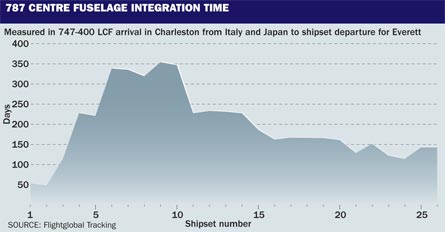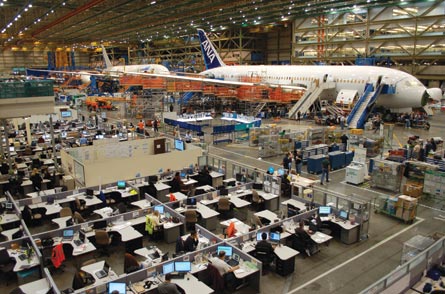When the Boeing 787 touches down at Farnborough later this month, the US airframer in one fell swoop will seek to erase the memory of the new composite twin's absence at the last two major midsummer air shows.
Yet, as the industry gathers for the 2010 Farnborough event, customers, suppliers and competitors remain mindful of the airframer's past, present and future challenges.
At the time of the Paris air show last year, Boeing was supposedly just days away from the first flight of the 787, with the company leadership concluding: "The technical issues are largely all behind us."
|
|---|
But before that show ended, executives were recalled to the company's commercial base of operations in Washington to review data collected from its static test airframe after a weakness in the side-of-body upper stringers had been found in full-scale testing the previous month. This caused delamination of the composite structure where the wings met the centre wing box.
Boeing contemplated flying the first Dreamliner, ZA001, at the end of June 2009, already 22 months later than originally planned, but opted against it following a passionate internal debate about whether to fly it with a significantly reduced, albeit airworthy, operating envelope.
Within days, Boeing had concluded its deliberations, announcing an indefinite hold in first flight of its flagship product while a technical solution was designed, manufactured and tested and a new schedule was hashed out.
The abrupt cancellation of the 787's first flight, the sixth such delay in getting the new twinjet into the sky, was another in an embarrassing series of setbacks for Boeing.
The result was a hard-to-install reinforcement in an even harder-to-reach area - akin to working inside a telephone booth turned on its side. This was accompanied by a further six-month slide in its first flight date and an addition of up to nine months to its first delivery to Japan's All Nippon Airways - which is now set for the end of this year - providing added buffer to its flight-test campaign.
Yet, as Boeing engineers toiled to solve the side-of-body equation, the airframer was redrawing the lines of authority around its supply chain, preparing to bring significant assembly work back under its control after two years of deploying significant manpower and monetary resources to help key suppliers keep up with deliveries.
On 7 July 2009, the same day that ZA001 would roll under its own power for the first time, Boeing announced it would spend $1 billion to acquire control of Vought Aircraft Industries North Charleston, South Carolina operations. The facility, which produces the aft fuselage of the 787, had struggled with its limited engineering and operational resources to keep up with the pace of production and design changes required by Boeing.
The acquisition was a pivotal milestone in the programme's history, marking a partial reversal in the company's make-buy balance that drove its business model, while further establishing a major assembly outpost outside the Pacific Northwest. Oversight of the facility provided a direct view to assembly of the aft fuselage, now the only part of the composite fuselage manufactured by Boeing.
Buying Vought's 787 operations, which followed more than a year after Boeing acquired the company's 50% stake in Global Aeronautica, responsible for centre fuselage integration, set off a proverbial starting gun in the race to locate the second final assembly line before a single hour had been flown by the Dreamliner.
While the choices for the second line eventually dwindled to the North Charleston campus and the sprawling Everett, Washington factory that already housed widebody final assembly lines, Pat Shanahan, vice-president of airplane programmes, summed up the decision from the company's perspective.
"The real options are around 'how do you secure assurance of delivery?' And I think that's been a discussion topic around some of the disruption we've realised...at Boeing," he said.

The "disruption" is Shanahan's reference to the International Association of Machinists (IAM), whose 57-day strike brought widebody production to a halt in September and October 2008. Two final pieces had to fall into place before Boeing made its final decision to locate the second final assembly line in Charleston.
The first came on 10 September when the new workforce of Boeing Charleston voted to derecognise the IAM, which represented the machinists, ensuring Boeing a union-free factory. The second was the final passage of an incentive package of low interest loans from the state of South Carolina, as well as sales tax exemptions of computers, material and fuel used in test flights said to top $900 million.
Boeing had held concurrent negotiations with the IAM in Seattle, as the company sought a 10-year contract with its largest union that included a no-strike provision. Those talks collapsed on 28 October. Boeing settled on North Charleston for its second 787 assembly line within minutes of the South Carolina House of Representatives passing the incentive package. Boeing Commercial Airplanes chief executive Jim Albaugh, who had replaced Scott Carson two months earlier, personally notified the Puget Sound-based employees of the board of directors' decision.
"While the union did not give us reasonable assurances or sustainable economics," wrote Albaugh, "this ultimately came down to a strategic decision for the long-term growth of the company."
Boeing's course was a break from its near century-long history, its first final new aircraft final assembly line in the USA since the company opened its Everett factory in 1968 for the 747.
|
|---|
The Charleston facility, when it begins final assembly on its first 787-8 in July 2011, will also feature a vertical fin and rudder shop, allowing all 787 structures to be built outside the Pacific Northwest. The first aircraft will be delivered in the second quarter of 2012, eventually ramping up to three aircraft a month.
That slow ramp-up will flow alongside Everett's steep ramp-up, including a temporary surge line, that will see 10 aircraft a month flowing out of both factories by the end of 2013.
But the challenge remains the same for Boeing as it pushes through its 3,000h flight-test programme, the swiftness in achieving airworthiness and type certification must be matched by its production system, which has showed signs of a growing maturity, but is still marked by an uneven stability that has twice resulted in a halt in shipments to final assembly in Everett.
In the previous year, Boeing has nearly tripled the number of 787s delivered to final assembly, going from the six flight-test aircraft just before the Paris air show, to 23 by 1 July and structural components for 25.
Shanahan forecasted in late May that the shipsets following Airplane 21 would see significantly increased completion. "We will see over the next 10 units that are delivered into Everett from [Mitsubishi Heavy Industries] and from Spirit they'll get to about 100% conditional assembly complete," he said.
However, Shanahan's statement belies the work yet to be done to bring Boeing Charleston, which now includes the former Global Aeronautica plant, responsible for integration of the Alenia Aeronautica and Kawasaki Heavy Industries centre fuselage structure - acquired fully by Boeing on 22 December - up to speed alongside Spirit and MHI.
For the supply chain as a whole, Shanahan says "we're with lead-time" if further capital investments are required for suppliers to achieve 10 aircraft a month, adding: "I think with some of the suppliers' part of that decision to go - to make a bet on investing to 10 [a month] is that they may find more capacity in what they've already capitalised."
He adds that the company is already finding ways to double composite laydown rates to accelerate production. However, in the global distributed supply chain, the weakest partner has a pacing impact on the programme.
"Our challenge is Charleston," says Shanahan. "That's why we're there. The situation out of Charleston from the former Vought facility was really more part shortages than it was engineering change; that's cleaning up."
One specific way Boeing has allowed the engineering changes to ease, was driven by a decision to not chase each modifications planned for the 787-9.
"Each one of those changes may flow in at a different blockpoint," says Fancher. "That was a really conscious decision in our part, that as the -9 is firming up, rather than getting into a tail chase as it was iterated with what we put into the -8, we wanted to let it settle out and just do it once."
At its peak, the integration time for a centre fuselage barrel was extended by nearly a year. Structures for Airplane seven arrived in late June 2008 and departed on the Dreamlifter for final assembly in Everett in mid-June of the following year.
Since that peak, which included production delays and the machinists' strike, the integration time has fallen as low as 114 days, but spiked again following the 24-manufacturing day hold, according to Flightglobal tracking.
He says the company is employing three approaches to bolster the production ramp-up at Boeing Charleston.
"One, we insert a high level of expertise where we have issues as the short-term fix. Longer-term, we have people from across the enterprise that have the experience we need and they're relocating permanently to Charleston."
Lastly, says Shanahan, there is "a heavy emphasis on really training the people in South Carolina and embedding the new type of culture we need to get the kind of performance we want out of that facility".
Boeing has planned a second resequencing of deliveries to Everett, starting in September following delivery of Airplane 27, that the company says will take advantage of "customer driven opportunities" and "further strengthen production system health", adding that the change is similar to that undertaken by the company in April, prompting a 24-manufacturing day hold on deliveries, which ended on 6 June.
QUALITY ISSUES AFFLICT DREAMLINER
As the supply chain came off a 24-manufacturing day hold in early June to allow supply partners to catch up on design changes and part shortages, workmanship issues on key structural areas of the aircraft again reared its head.
On 24 June Boeing had to disclose that it was forced to undertake inspections on the entire fleet of the horizontal stabilisers built by Alenia Aeronautica in Foggia, Italy, following the discovery of over-torqued fasteners and improperly installed shims in the rear spar.
Programme sources say the gaps, which the shims are intended to fill, range between 0.25cm and almost 0.5cm, and the ones used to fill gaps in the horizontal stabiliser became compressed after fasteners were over-torqued as a means of pulling the surfaces together.
This caused a "pre-load" condition that can undermine the fatigue life of the structure.
While Boeing maintains that the fleet had not been "grounded", the company decided not to fly each aircraft until it underwent two-day inspections before returning to flight-test operations.
The company insists that quality "escapes" such as the one found in the horizontal stabiliser is not uncommon during the early part of a programme.
The episode was another in a series of workmanship issues that prompted an internal inquiry as to how 25 horizontal stabilisers could have been shipped to Everett over three years without notice.
Nearly a year ago, Boeing ordered a work stoppage at Alenia after wrinkles in the skin of the composite fuselage barrels exceeded tolerances.
"It turns out [the issue] is fairly deeply imbedded in the assembly," says Scott Fancher, vice-president and 787 programme general manager, referring to the issue with the horizontal stabiliser.
"So we're in the process of auditing the records associated with that to understand whether or not there's a systemic issue with the escape or whether it's a one-off."
Source: Flight International





















